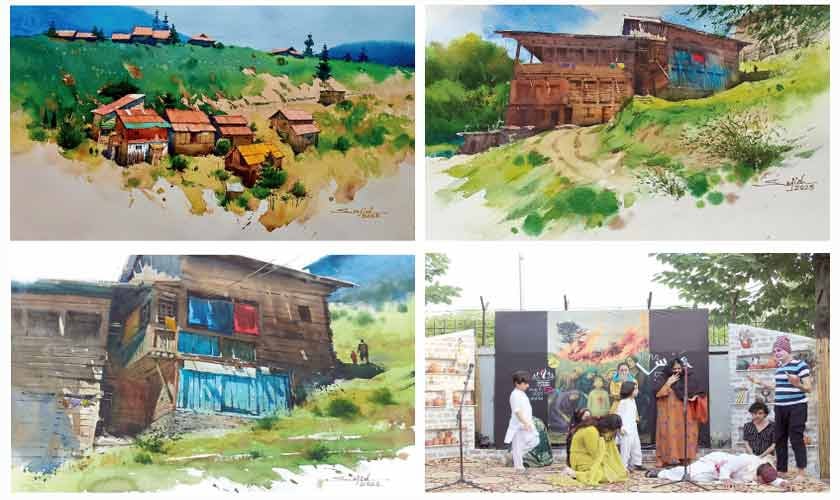Peshawar is an ancient city steeped in history, culture, and diversity—a vibrant hub for literary and cultural activities. Nestled at the crossroads of Central Asia and the Indian subcontinent, Peshawar has long been a melting pot of civilizations, from the Gandharan era to the Mughal period and beyond. This rich historical tapestry, coupled with its resilient Pashtun identity, has fostered a dynamic environment where literary and cultural activities thrive, serving as a bridge between tradition and modernity.
Recently, the city has resumed its literary and cultural activities after a long heat spell subsided. Events such as mushairas (poetry recitals), book fairs, and storytelling sessions play a pivotal role in preserving the region’s linguistic heritage. These gatherings provide platforms for poets, writers, and scholars to express ideas, share narratives, and engage with pressing social issues.
Pashto, Hindko, and Urdu poetry are deeply rooted in themes of love, honour, and resistance—resonating strongly with the city’s ethos. The literature produced in the region reflects both local and cosmopolitan influences. Institutions like the Abasin Arts Council and various literary circles foster intellectual discourse, nurturing young talent and encouraging creative expression.
Culturally, Peshawar is a kaleidoscope of traditions. Historically, the city’s pluralistic identity has been widely celebrated. Cultural events not only entertain but also strengthen communal bonds by offering a space for dialogue in a region often marked by conflict. Places like the Peshawar Museum, which houses numerous Gandharan artifacts and hosts cultural festivals, highlight the city’s historical significance and continue to attract scholars and tourists alike.
Literary and cultural activities in Peshawar are more than mere entertainment; they are vital for preserving heritage, fostering resilience, and promoting social cohesion. In a city that has faced challenges like militancy, these activities provide a creative outlet for healing and expression, ensuring that Peshawar remains a beacon of cultural richness and intellectual vitality in the region.
### Honouring Professor Dr. Nazir Tabassum
Halqa Arbab-i-Zauq, Peshawar, recently organized a literary conference to honour the services of Professor Dr. Nazir Tabassum (d. 2025), a distinguished Urdu poet, scholar, and teacher. His significant contributions to Urdu literature were highlighted during the event.
Born as Nazir Ahmad, Dr. Tabassum earned his MA in Urdu from Peshawar University in 1974 and completed his PhD in 2003. His doctoral thesis on “Urdu Ghazal Poets of the Frontier After the Creation of Pakistan” received acclaim for its scholarly depth. Many of his students continue to enrich Pakistan’s literary and academic landscapes.
Dr. Tabassum’s poetry, marked by emotional depth and social reflection, resonated with a wide audience. His collections—*Tum Udaas Mat Hona* (1996), *Kaisay Raigan Huye Hum*, and *Abhi Mausam Nahin Badla*—explore personal and cultural themes, often reflecting Peshawar’s unique ethos. His verses, shared on platforms like Rekhta, blend introspection with contemporary issues, earning him a revered place in Urdu poetry.
As a member of Halqa-i-Arbab-i-Zauq—a literary movement founded in 1939 in Lahore—he actively participated in poetic gatherings and critical discussions, contributing to the modernist Urdu literary tradition. Known for its non-political focus and innovative poetic styles, Halqa-i-Arbab-i-Zauq recognized Dr. Tabassum’s work for its clarity and emotional resonance.
His untimely death from a heart attack during a mushaira at the Peshawar Services Club in August 2025 was mourned as an irreparable loss. Prominent literary figures, including Khyber Pakhtunkhwa’s Culture Department Secretary Dr. Abdul Samad and Federal Minister Aurangzeb Khichi, lauded his contributions. Halqa-i-Arbab-i-Zauq and the Dosti Welfare Organisation later organized an event to honour his legacy as a literary icon.
### The Peshawar Circles Discuss Artificial Intelligence
The Peshawar Circles—a group of university graduates—recently held their 51st study circle at the Incubation Centre, where the book *AI Snake Oil: What Artificial Intelligence Can Do* by Arvind Narayanan and Sayash Kapoor was discussed.
This book critically examines the hype surrounding artificial intelligence, pointing out its limitations and societal implications. The keynote speaker, Faisal Jamil, and moderator, Hamza Bin Anees, highlighted salient features of the book and encouraged young readers to explore innovative ideas and their practical applications.
The book categorizes AI into two types: generative and predictive. Generative AI, such as chatbots (e.g., ChatGPT) and image generators, excels in creating human-like outputs but often struggles with factual accuracy, sometimes producing hallucinations—plausible but false information. Narayanan and Kapoor emphasize that AI’s allure stems partly from its versatility and the exaggerated marketing by tech companies and consultants.
The authors advocate for a critical approach to AI adoption, urging stakeholders, policymakers, businesses, and the public to demand evidence of efficacy alongside ethical considerations.
### Mafkoora’s Cultural Activities and Artistic Contributions
Mafkoora, a private organisation dedicated to research and development, recently staged a Pashto play focused on peace, climate change, and the right to free expression. Hayat Roghani, the head of the organisation, explained that live theatre is part of a series of cultural activities planned for the year. According to Roghani, live performances are an effective medium for promoting social causes such as peace and environmental awareness.
Additionally, Mafkoora organised a session on the Big Bang Theory, further enriching the city’s cultural dialogue.
In the visual arts scene, Ali Sajid, a noted watercolour artist based in Peshawar and president of the National Artists Association of Pakistan’s Khyber Pakhtunkhwa chapter, recently released his latest work online. This includes a painting of the pre-flood Gurez Valley of Azad Jammu and Kashmir. Sajid remarked that such pre-flood images could be instrumental in rebuilding and reclaiming the landscape.
—
Peshawar’s vibrant literary and cultural landscape continues to thrive through the dedication of its artists, scholars, and cultural organisations. These endeavors not only preserve the city’s rich heritage but also foster resilience and social cohesion—a testament to Peshawar’s enduring spirit and intellectual vitality.
https://www.thenews.com.pk/tns/detail/1345121-an-active-autumn




